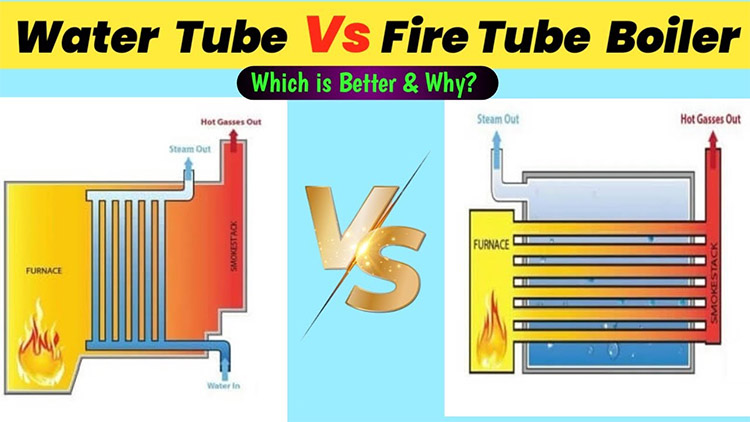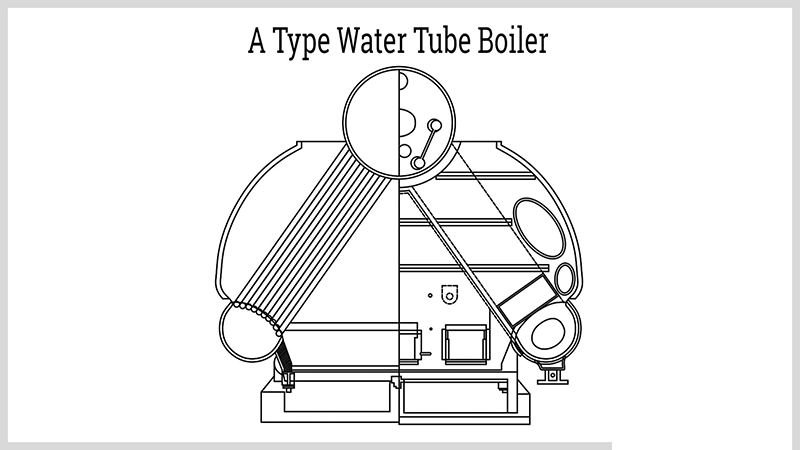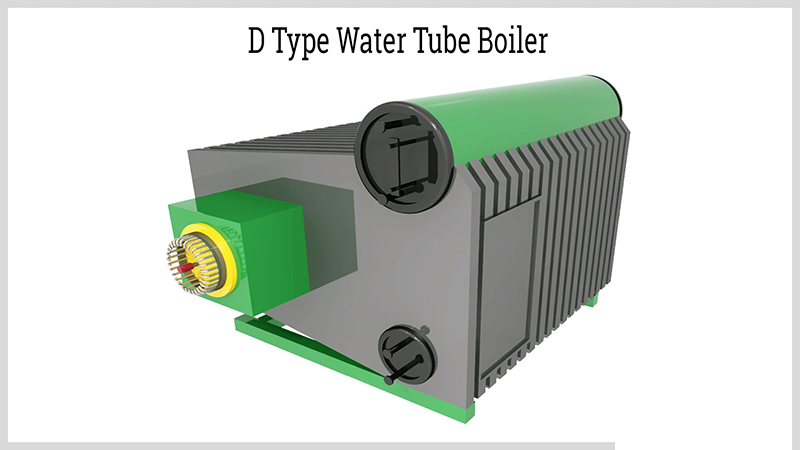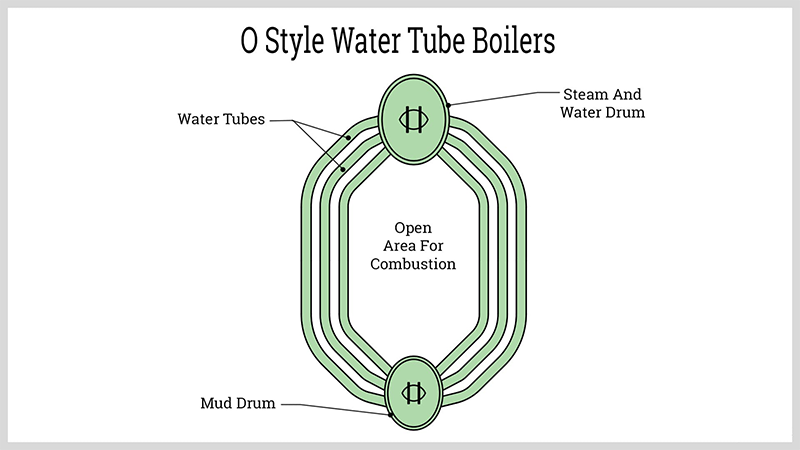Steam is widely used in modern industry and life, from power generation to industrial production to district heating. As one of the main steam generating equipment, the water tube boiler plays a vital role in it. In this article, we will discuss the internal working mechanism, components, types, applications and advantages of water tube boilers to provide you with a comprehensive answer to the question of how water tube boilers work.
What Is A Water Tube Boiler?

A water tube boiler is a type of boiler that generates steam through water-filled tubes. This is different from a firetube boiler, which generates steam using pipes filled with flame or exhaust gases. The steam produced by a water tube boiler is used for a variety of purposes, including generating electricity through a steam turbine, for industrial processes, and for heating buildings (district heating).
Components Of A Water Tube Boiler
Boiler Shell
The boiler shell is the external cylindrical part of the pressure vessel. Its primary function is to house the internal components of the boiler and to maintain internal pressure to ensure the safe operation of the boiler.
Mud Drum
The mud drum is located at the bottom of the water space and is cylindrical in shape. Its function is to collect impurities in the water, such as mud and sediment, to prevent these impurities from affecting the normal operation of the boiler.
Filter
A filter acts as a filtration device that blocks solids and allows only fluid to pass through. It is vital in preventing solid impurities from entering the boiler system and protecting the internal components of the boiler.
Water Level Gauge
A water level gauge is usually a glass tube that is installed on a steam boiler to visually display the water level inside the boiler. Accurate knowledge of the water level is one of the key factors in ensuring the safe and proper operation of the boiler.
Safety Valve
A safety valve is a spring-loaded valve that automatically opens to release excess pressure when the pressure exceeds a set value. It effectively prevents boilers from becoming dangerous due to excessive pressure and ensures boiler safety.
Furnace chamber
The furnace chamber is the space where the fuel is burned. Fuel is burned in the furnace chamber to generate heat and provide the necessary energy for the production of steam.
Feedwater Test Valve
The feedwater test valve allows high-pressure water to flow into the boiler. It is an important conduit for supplying water to the water-tube theory boiler, ensuring that there is enough water in the boiler to produce steam.
Steam Shutoff Valve
Steam shut-off valves are used to control the flow of steam out of the boiler. By adjusting the steam flow, the amount of steam required for different application scenarios can be met.
Burners
The burner injects air and fuel into the boiler at the proper rate and is a key piece of equipment in the combustion of gas or oil. Its performance directly affects fuel combustion efficiency and heat production.
How Water Tube Boilers Work
Introduction of Drums and Cylinders
The water tube boiler mainly consists of two drums: the one located above is called the steam drum, while the one below is the mud drum.
Rising and Falling Tubes
The steam drum and the mud drum are connected to each other by means of a rise tube and a fall tube.
Steam Generation Process
In the mud drum and the connecting rising tube, water is heated to produce steam. Since steam is less dense than water, it naturally rises into the steam drum. Inside the ladle, the steam and water are naturally separated and the steam accumulates above the water surface.
Water Circulation
Cold water enters the boiler system through the feedwater inlet located on the steam drum. Since the cold water is denser than the hot water in the mud drum and riser tubes, pressure is generated that pushes the hot water upward through the riser tubes, thus creating a convective circulation of water through the boiler system.
Pressure in Relation to Steam Production
As steam production increases, the pressure within the closed system rises, which prevents convective circulation of water and results in a corresponding slowdown in steam production. Conversely, when steam is withdrawn through the steam outlet, the pressure in the system decreases, convective circulation of water is accelerated, and the rate of steam production increases.
Self-Control Characteristics
water tube boilers are able to regulate pressure by controlling the convective circulation of water, making them self-controlling devices, often referred to as self-control machines.
Different Types Of Water Tube Boilers
Single Process Vertical and Bent Tube Design
This design has a unique construction. The single flow vertical design is simple and straightforward and is used in applications where space height is required and steam demand is relatively small. The curved tube design increases the contact area between the water and the hot flue gases, which improves thermal efficiency and is often used in industries with high steam quality and production requirements. They can withstand design pressures up to 2000 psig, temperatures up to 1000°F (537.78°C) and capacities up to 500,000 pounds per hour (PPH).
A-Type water tube boilers

The Model A water tube boiler has two water drums connected by a common header pipe. The evaporated water is transported upward through the riser tubes to the steam drum and steam header tubes. Characterized by a water-cooled furnace chamber and vertical gas outlet, this design reduces the boiler's footprint and achieves high steam production in a compact space. The A-Type is so named because of the triangular arrangement of the two water drums and the steam drum. In this boiler, water fills the space between the drums and the furnace is centered. It can be fueled by either coal or oil and is equipped with multiple doors for adding coal. Originally designed for battleships, the A-Type water tube boiler was intended to provide great power in a compact space.
D-Type water tube boiler

The Model D water tube boiler has a large steam ladle at the top and a mud drum attached at the bottom. Steam is generated in tubes or risers and rises to the ladle. All four walls of the furnace have water-filled pipes, known as water-cooled walls. This design greatly facilitates water circulation, allowing for rapid steam generation and output. the Model D water tube boiler is capable of generating steam at outputs of up to 1,000,000 lbs. per hour at pressures up to 2,000 psig. it is designed for durability, longevity, and longevity, and is ideally suited for applications that require high-pressure, superheated steam in a compact, space-saving environment.
O-Type water tube boilers

In the O-Type water tube boiler, the steam drum and mud drum are arranged vertically, one above the other. They are connected by curved water tubes that form the shape of the letter “O”. These boilers use liquid burners for combustion, and the combustion chamber is located between the curved convection tubes and the water-cooled wall tubes. Similar to the D-Type water tube boiler, the O-Type water tube boiler is suitable for environments where space is limited. It is easy to maintain at both ends. Known for its durability and long service life, the O-Type water tube boiler can produce up to 250,000 pounds per hour at pressures up to 900 psig.
Industries That Commonly Use Water Tube Boilers
Power Generation
In power stations, steam from water tube boilers is used to drive turbines to generate electricity. Many large power stations utilize water tube boilers because of their ability to consistently produce large quantities of high-temperature, high-pressure steam to meet power generation needs. For example, some coal-fired and gas-fired power stations use water tube boilers to convert chemical energy into the internal energy of steam, which is then converted into electrical energy.
Chemical and Petrochemical Industries
In the chemical and petrochemical industries, water tube boilers are used to produce steam for processes such as refining, distillation and cracking. In oil refining, high temperature steam is needed to fractionate crude oil and separate the different components of the oil. In chemical production, many chemical reactions need to take place at specific temperatures and pressures, and steam provides the necessary conditions for these reactions.
Pulp and Paper Industry
In the pulp and paper industry, steam from water tube boilers is used for pulp cooking, paper drying and power generation. During the pulp cooking process, steam helps break down raw materials such as wood to make pulp. In the paper drying process, steam provides heat to quickly evaporate the water in the paper and improve production efficiency. At the same time, some of the steam can be used to generate electricity to meet the mill's own power needs.
Food and Beverage Industry
The food and beverage industry utilizes steam generated from water tube boilers for operations such as canning, pasteurization and sterilization. In canned food production, steam is used to sterilize cans at high temperatures to ensure shelf life and safety. In beverage production, the pasteurization process requires precise temperature control, and steam provides a stable heat source to ensure beverage quality.
Pharmaceutical Industry
The pharmaceutical industry uses steam from water tube boilers for distillation, sterilization and drying processes. In the pharmaceutical manufacturing process, the purity of steam is extremely high, and water tube boilers are able to produce clean steam that meets these requirements. For example, in the sterilization of pharmaceuticals, high temperature and high pressure steam can completely kill bacteria and viruses, ensuring the quality and safety of pharmaceuticals.
Textile Industry
The textile industry utilizes steam for dyeing, printing and finishing processes. In the dyeing process, steam can help the dyes to better adhere to the fabric and improve the dyeing effect. In the printing process, steam can make the printing pattern clearer and stronger. In the fabric finishing process, steam can make the fabric flatter and softer, improving product quality.
Ship and shipping industry
In the ship and shipping sector, water tube boilers are used for ship propulsion and power generation. For large merchant ships and warships, the steam generated by watertube boilers drives a turbine to power the ship. At the same time, they provide electricity and hot water for various equipment and amenities on board.
District Heating
District heating systems utilize water tube boilers to generate steam to provide heat for multiple buildings. The steam is transported to each user through piping to achieve centralized heat supply. This approach not only improves the efficiency of energy use, but also reduces the environmental pollution caused by decentralized heating.
These industries choose the water tube boiler because of its high thermal efficiency, ability to produce high pressure steam, and large steam output. It is also adaptable to high-pressure, high-temperature application scenarios and can use a variety of fuels.
Water Tube Boilers vs. Firetube Boilers
Design Differences
As you can see from the name, the main difference between a water tube boiler and a fire tube boiler is the way the fire and water are handled. A water tube boiler has pipes (tubes) filled with water, surrounded and heated by hot gases, while a fire tube boiler has pipes (tubes) filled with a flame that heats the surrounding water.
Pressure capacity
Because the diameter of the steam drum and mud drum of a water tube boiler is much smaller than the diameter of the larger shell of a fire tube boiler, it can be designed for higher pressures. Many power plants are designed for pressures in excess of 3,000 psi, whereas fire tube boilers have difficulty reaching such high pressures.
Capacity Differences
water tube boilers have a much larger surface area and their capacity can be increased to tens of times that of the largest fire tube boilers. This allows water tube boilers to meet the huge demand for steam for large scale industrial production and power generation.
Safety Differences
The large cylindrical chamber of the fire tube boiler is replaced by a tubular water-cooled combustion chamber, which makes water tube boilers safer. In the event of an overheating situation, a water tube boiler will only result in damage to individual small tubes, rather than the failure of an entire large furnace tube as is the case with a fire tube boiler, thus reducing the risk of accidents.
Advantages Of Water Tube Boilers
High Efficiency
water tube boilers have excellent heat transfer capabilities, enabling efficient energy conversion and optimized fuel utilization. Their unique structural design allows for a large contact area between water and hot flue gases and rapid heat transfer, resulting in increased energy efficiency and lower operating costs.
High-pressure steam generation
It is capable of generating high-pressure steam to satisfy industrial production processes that require high-temperature steam. For example, in some chemical synthesis reactions, high-temperature and high-pressure steam is required as a reaction condition, and the water tube boiler is well suited to meet this demand.
Quick response to load fluctuations
water tube boilers can quickly adjust steam output in response to changes in demand. When there is a sudden increase in the demand for steam in the industrial production process, it can quickly increase steam output; when the demand decreases, it can promptly reduce output to ensure operational efficiency and reduce energy waste.
Enhanced Safety Features
water tube boilers are equipped with a variety of safety mechanisms and feature a robust structural design. Safety valves, water level gauges, and other safety devices prevent tube failures and reduce the risk of thermal shock and explosion, providing a safe working environment for operators.
Compact size and space efficiency
For installations where space is limited, water tube boilers are ideal. Its compact design saves a lot of space without compromising on performance and functionality. For example, in some urban industrial plants, where land resources are limited, water tube boilers are well adapted to this environment.
Reduced water demand
The continuous circulation system of the water tube boiler minimizes water consumption. This feature is especially important in areas where water is scarce or where water conservation is important. By recycling water, it not only reduces production costs, but also helps the environment.
Disadvantages Of Water Tube Boilers
Complexity of on-site work
A water tube boiler requires more work to install on site than a fully-assembled boiler with a pot shell. It has more components and the installation process is more complex, requiring specialized technicians to operate it, which increases the installation cost and time.
Complex control systems
Some water tube boilers, particularly those used in power stations, may be equipped with 30 or more burners. While this multi-burner configuration provides flexibility, it also requires complex control systems to coordinate the operation of the individual burners. In practice, implementing and maintaining these complex control systems presents a number of challenges, such as system troubleshooting and software upgrades.
Conclusion
Summary
This paper describes in detail the working principle, component parts, types, application areas of water tube boilers as well as their comparison with fire tube boilers and their own advantages and disadvantages. water tube boilers play an important role in many industries due to their high efficiency, high pressure steam generating capacity, and fast response to load changes.
Future Prospects
With the continuous progress of technology, water tube boilers are expected to make further improvements in energy efficiency, intelligent control and environmental performance. For example, the use of new materials to improve the boiler's resistance to high temperatures and corrosion, and the optimization of combustion technology to reduce pollutant emissions.

























